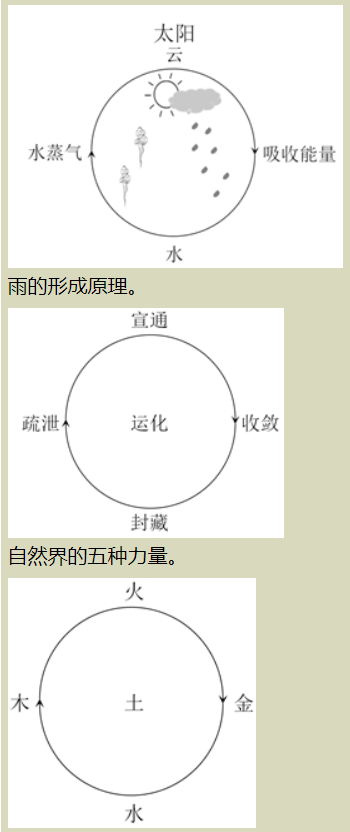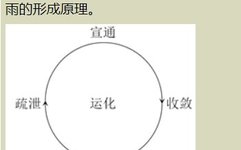 Click on the above “Public Account” to subscribe!
Click on the above “Public Account” to subscribe!
Many people feel confused when they first learn about Traditional Chinese Medicine (TCM) and encounter the Five Elements, such as Metal generating Water, Water generating Wood, Fire overcoming Metal, and Wood overcoming Earth. However, the Five Elements are not as obscure as they seem; they belong not only to TCM but to the entire world and universe. Once you truly understand the essence of the Five Elements, everything becomes simple.
In the foundational theory of TCM, the Five Elements are Wood, Fire, Earth, Metal, and Water, corresponding to the five forces of dispersing, communicating, transforming, gathering, and storing, which exist in mutual relationships of generation and overcoming. We can use the Five Elements to interpret the mysteries of the human body and categorize all things in the world according to these elements.
The Five Forces of Nature
The complex world is merely composed of Metal, Wood, Water, Fire, and Earth. The relationships and transformations among these five forces can be clearly illustrated through the process of rain formation.
The gentle drizzle of the Qingming season, the torrential downpour of summer, and the lonely light rain of golden autumn are common weather phenomena. But how is rain formed? Simply put, the process of rain formation involves the sun’s heat being absorbed by seawater, river water, and groundwater. As the heat accumulates in the water, it reaches a certain temperature, causing the water to evaporate into water vapor, which rises to the sky and condenses into clouds. Under certain conditions, these clouds disperse, resulting in rain falling down.

The process of rain formation reflects the mutual transformation of the five energies. The sun’s heat provides energy to the Earth, demonstrating the ability to communicate. Although the sun’s temperature is high, we do not feel it intensely when sunlight reaches the ground because the water and other substances on Earth can absorb heat. This ability to absorb energy is known as gathering. When heat is absorbed by water, it can temporarily store energy, which reflects the ability to store. It is this storing ability that gives animals, plants, stones, soil, and water a certain temperature. However, the water’s storing capacity is limited; when energy is stored to a certain extent, water transforms into water vapor, and at this point, energy rises with the water vapor, which is the dispersing force. Another force is transformation. Transformation regulates the conversion of other forces and the speed of these conversions. When the surface water has stored energy to a certain extent, it begins to transform into water vapor and rise, a process regulated by transformation, allowing for a gradual change. Without this transformative function, water might suddenly turn into gas or not change at all.
It is precisely the conversion of these five forces that leads to the occurrence of rain. Energetic substances exert a communicative force, transferring energy to substances with lower energy, while the ability of low-energy substances to receive energy is called gathering; during gathering, substances store energy, and this storing ability is called storing; when storing reaches a certain level, low-energy substances transition from receiving energy to supplying energy, at which point the supplying ability has not yet reached the strength of communication, leaning more towards a dispersing force; and this accumulating dispersing force eventually transforms into a communicative force. The difference between dispersing and communicating is that dispersing is more about flow and has a stronger push, while communicating is more about supplying energy and has a warmer strength. These four forces form a circular motion, with transformation existing in the transitions between these four forces, thus placing it in the center of this circle. This circle is what Huang Yuan-yu often refers to when explaining medical principles.
It is evident that our seemingly complex Earth is actually governed by these five forces. The gathering force is called Metal, and everything related to gathering belongs to Metal. For example, the process of rain is a manifestation of Metal’s gathering force. The lungs can gather external Qi, so in the Five Elements, the lungs belong to Metal. Everything related to storing belongs to Water… By using these five forces to label the world around us, we can categorize all things according to the Five Elements. Under the transformation of Earth, Metal’s gathering leads to Water’s storing, and when Water has stored to a certain extent, it will lead to Wood’s dispersing, with Wood accumulating heat and transforming into Fire, and Fire overcoming Metal. Understanding the generation of the Five Elements becomes quite easy this way. Overcoming is a state of opposition; the overcoming of the Five Elements is not simply one element overcoming another, but sometimes involves mutual restraint. Water overcomes Fire, as Water can extinguish Fire, but this is only because, at that moment, Water’s storing ability is greater than Fire’s communicative ability. If Water is less than Fire, Fire can quickly evaporate Water. Therefore, not absolutizing the generation and overcoming of the Five Elements is very helpful for learning TCM.
So why are the names Metal, Wood, Water, Fire, and Earth used to summarize the Five Forces?
In the eyes of our diligent and wise ancestors, these five substances best represent the meaning of the Five Elements. For example, the continuous growth of trees fully embodies the dispersing and generating force. Earth, situated between heaven and earth, allows the sun’s light and heat to be transmitted underground, and the growth of trees requires the nourishment of Earth, thus Earth can well explain what transformation is. Metal is heavier than the other four substances, representing the force of descent and gathering.
The Five Elements in Humans
Humans are a combination of Yin and Yang, composed of energy and the material that carries energy. To coordinate the complex functions of the body, the energy within the human body transforms into different forms with the assistance of matter.
Daily activities such as walking, eating, playing, exercising, and thinking all require energy consumption, so a portion of the energy in the human body directly manifests its supplying nature, which we call “Fire”; the discharge of impurities and waste requires a dispersing force to push it out, and the flow of blood in the vessels also requires a pushing force, so some energy in the body transforms into a dispersing nature, which we call “Wood”; to prevent excessive accumulation of energy in the body that could lead to an “explosion,” some energy is gathered and stored in matter, which we call the gathering process “Metal,” and the storing process “Water”; the Yang Qi and Yin body in the human body are replenished by food and water, and the transformation of food and water into Yin and Yang requires a transformative force, which is also formed by energy changes, and we call the energy that performs the transformative function “Earth.”
To accomplish various complex physiological and psychological activities, energy exists in the human body in the forms of Metal, Wood, Water, Fire, and Earth, and they form a complete system that we have summarized from the circular motion system of the Five Elements observed in the rain process.
The Earth is a combination of energy and matter, and the human body is also a combination of Yin and Yang. In the Earth, high-energy substances transmit energy to surrounding substances, which can accept and store energy, and when energy accumulates in matter to a certain extent, it will burst forth. The Yang Qi and Yin body in the human body naturally move and change in the same way. Therefore, it is undeniable that the energy and matter in the Earth operate according to the circular motion laws of the Five Elements, and the operation of Yin and Yang in the human body must also follow the same circular motion laws.
Even more astonishing is that the laws of humans and nature are not only the same but also follow each other. A person’s feelings of love are more likely to awaken in spring, leading to interest in new things and a tendency to express affection, which is why most people get married in spring; in summer, people are more energetic and capable of creating miracles in their careers, which is why major events like the Olympics and World Cup are often scheduled in summer; in autumn, people tend to feel low and nostalgic, missing their hometown and loved ones, and they lack the enthusiasm of summer in their work; winter is the best season for sleeping, with some people willing to skip meals just to sleep, and many animals choose to hibernate during this season.
The plan for the year is made in spring, and the plan for the day is made in the morning. People often feel a refreshing feeling in the morning, as if they are bathed in spring breeze; noon is the time of day when energy is at its peak, which is why we tend to eat more at noon; in the afternoon, people are often lazy, preferring to gather with a few close friends to enjoy tea and delicious desserts; after a long day of work, after dinner, taking a bath, we all go to sleep.
The changes in energy follow an ancient and unchanging circular motion law; both nature and human energy change according to this circular motion law, and the laws of the human body also align with nature. Therefore, as long as we clarify and thoroughly explore the laws of energy movement, combined with the idea of the unity of heaven and man, we can uncover the mysteries of the human body and naturally solve health issues. This is TCM, the TCM of the unity of heaven and man.
Written by Chen Xisheng, Guangzhou University of Chinese MedicineEdited by Li NaReviewed by Li Xiuyun

